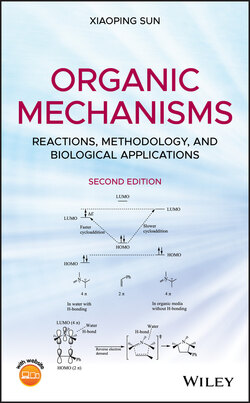Читать книгу Organic Mechanisms - Xiaoping Sun - Страница 34
1.9 ELECTROPHILES/NUCLEOPHILES VERSUS ACIDS/BASES
ОглавлениеIn organic chemistry, any chemical species that function as acceptors of an electron pair (2e) from another species are termed electrophiles. In contrast, any species that function as donors of an electron pair (2e) to an electrophile are termed nucleophiles. In inorganic chemistry, the electron‐pair acceptors (electrophiles) are called Lewis acids. The electron‐pair donors (nucleophiles) are called Lewis bases. Therefore, by the nature, electrophiles and Lewis acids are equivalent terms, and they are used to describe the same type of chemical species. Nucleophiles and Lewis bases are another set of equivalent terms, and they are used to describe another same type of chemical species.
Electrophiles are electron‐deficient species so that in chemical reactions they can accept a pair of electrons from a nucleophile to form a covalent bond. In contrast, nucleophiles are electron‐rich in order to be able to donate a pair of electrons to an electrophile to form a covalent bond (Eq. 1.62) [1, 6].
(1.62)
An electrophile can be a cation (positively charged) or a neutral molecule. In general, in order for a neutral molecule to be an electrophile, the molecule usually should contain a polar covalent bond, with the reactive center (the atom that accepts an electron pair) being partially positively charged. Alternatively, if an atom in a neutral molecule contains an empty orbital (typically, a p orbital), the molecule can also be an electrophile, with the reactive center being on the atom that contains the empty orbital. A nucleophile can be an anion (negatively charged) or a neutral molecule. In general, a nucleophile contains at least one lone‐pair of electrons which is relatively active and able to be donated to an electrophile forming a covalent bond (Eq. 1.62). In some types of molecules, a bonding electron‐pair including σ‐bond and π‐bond electrons can also be donated to an electrophile forming a covalent bond.
Now let us go over briefly some common types of electrophiles and nucleophiles. In Chapters 6 and 7 on individual types of reactions, we will present more intensive discussions on electrophiles and nucleophiles.
